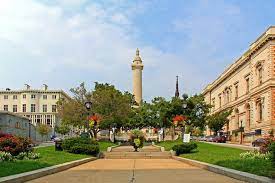It’s Beautiful. But Is It Safe?

I’m spending the week in Baltimore, where my primary client is headquartered. I’m here for meetings about the receding economy, the effect it’s had on our industry, and the challenges it poses to our business right now.
Baltimore is an interesting small city. It has as much history as just about any city in the country. It has been the headquarters to more than its share of Fortune 500 companies. It has some beautiful buildings, a couple of excellent museums, ample good restaurants, a half-dozen nice little parks (one of which I’m sitting in right now), and all the diversity a SJW could want.
But in most measurable ways, Charm City is going downhill.
For one thing, Baltimore has a serious crime problem, ranking well above the national average. Violent crime spiked in 2015 after the death of Freddie Gray, which touched off riots and an increase in murders. The city recorded 344 homicides that year, or 55.4 per 100,000, the highest rate per capita in its history. And despite efforts to reduce the murder rate, it has continued to climb.
This trend is not limited to Baltimore. At least 10 other cities, including Washington, DC, Chicago, LA, and Milwaukee have experienced the same rise in violent crime. Not only homicides, but also rapes, robberies, and aggravated assaults.
And yet, if you were sitting here in Mount Vernon Square right now, looking at Baltimore’s own Washington monument, you might find all this hard to believe. That’s because, like the other cities mentioned above, most of the violent crime here, approximately 80%, occurs in what they call “underserved” neighborhoods – i.e., largely African American neighborhoods infested with drugs and the gangs that traffic drugs.
So, the mainstream media doesn’t report on it. And the conservative media points it out only to blame it on the Democrat mayors, DAs, and other city officials that run these cities.
But that still leaves 20% of the crime taking place in “safe” neighborhoods like Mount Vernon, where our offices are. And that 20% counts. It is where Baltimore’s businesses, big and small, are located. It is where most of the city’s workers spend their days, both in their offices and at restaurants and shops before and after work. Safety here is an issue. It was always a risk, but a minor risk. Since 2015, though, as I pointed out above, it’s become a serious risk. Employers like us are becoming increasingly uncomfortable with the danger our employees are subjected to on a daily basis.
Since the pandemic mandates, a sizable portion of our employees have been working remotely. Among other advantages, this means they don’t have to worry about being mugged on their way to work. Efforts to bring them back to the office are being met with considerable resistance. This begs the question: Would we be better off if we were located somewhere else?
Politicians can shrug off a rise in violent crime when most of is contained within the drug zones. But when the primary employers of the city’s population begin to move out, how will these cities deal with an accelerating unemployment rate that is sure to follow?
 MarkFord
MarkFord